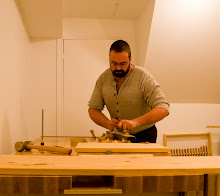
I've had this lathe for years. It's been sitting in the shed at my folks' farm for all of that time, but I've finally brought it home. I'm going to put a fresh coat of paint on the old girl, and this will be the story of that process. I think the lathe was made in Toronto quite a while back. Some time near the turn of the 20th century. It's also possible that it was merely sold by a Toronto company, and may have been made elsewhere some time previously. If it was, indeed, made in Toronto then it would have had to have been made after about 1910.
The first decision to be made is whether to treat this as a restoration or a re-creation. Do I try to maintain the ancient patina, and keep the aged look, or do I try to make it look the way it would have when it left the show room all those years ago? I'm leaning towards the latter. I think it would look dead sexy with a fresh coat of bondo, a new skin of gloss black paint, and gold pin-striping. Below is a shot of the maker's plate. Actually, maybe green... deep green... with gold highlights.... hmmm...


4 comments:
The material that has come away is body-filler. In the earlier days of casting iron it was quite common to have voids and air bubbles at the surface. It still happens today, though it is less common today. These voids would often be filled with something approximating 'Bondo' as is used on automotive finishes.
For a while it was the style for machine tools to be completely smooth and detailed. The castings would be bolted together then the whole thing would be coated with filler, similar to plastering a wall. The filler would be sanded and you'd be left with a smooth surface for paint.
Yes, Garlock and Walker were at that address at some point at the turn of the century, but it's tough to pin down when they were there. The building was built around 1910, but it held multiple tenants. Bakelite Ltd. was in the building at the same time as G&W, and there may have been others.
It's looking more and more like G&W were the dealers, not the manufacturers.
M.Mike
Post a Comment